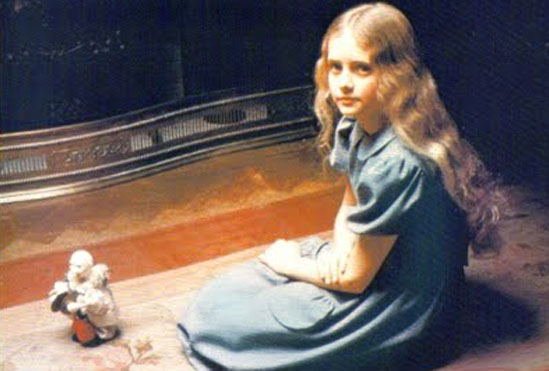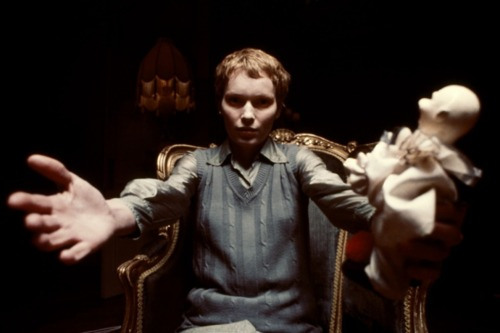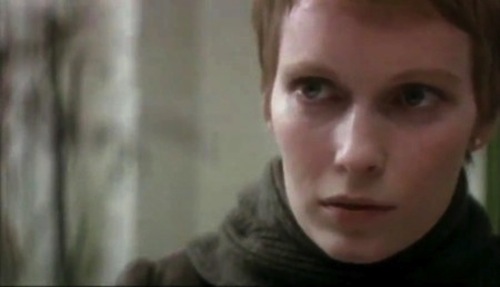In 1968, after a successful run on television’s “Peyton Place,” actress Mia Farrow finally broke through to big-screen audiences in Roman Polanski’s influential horror film Rosemary’s Baby. Although Farrow would go on to play straight roles in works such as The Great Gatsby and a television production of “Peter Pan,” she never failed to keep her horror fans happy with films like See No Evil and Secret Ceremony. In 1977, she made her most frightening film since Rosemary’s Baby when she starred in The Haunting of Julia.
The Haunting of Julia begins with Julia Lofting (Farrow) and her husband, Magnus (Keir Dullea from 2001: A Space Odyssey and Black Christmas), having breakfast with their young daughter, Kate (Book of Blood’s Sophie Ward). Suddenly, Kate starts to choke on a piece of an apple, and her parents panic. While Magnus calls an ambulance, Julia decides that there is not enough time to wait for help and tries to give the girl an emergency tracheotomy. Sadly, the girl dies. The tragedy ends Julia and Magnus’ marriage and Julia, trying to get a fresh start, moves into a new house. However, her peace does not last long; the grieving woman sees the image of her dead daughter everywhere she looks, in the house and out. A séance held by a few of Julia’s friends confirms the presence of spirits in her home, but the medium, Rosa Fludd (Xtro’s Anna Wing), will not confirm whether or not the ghost is Kate; she only tells Julia that she should leave the house and never come back. With the help of her friend, Mark (Tom Conti from Derailed), Julia investigates, uncovering the house’s past and figuring out the identity of the spirit – an antagonistic little girl with her own agenda who is pretending to be Kate. As Julia unravels the secrets of the ghost, people around her start to die…but, are the deaths the doing of the spirit, or are they just coincidences? And is the spirit real or all in Julia’s mind?

Originally titled Full Circle, The Haunting of Julia was adapted from iconic horror novelist Peter Straub’s “Julia” by screenwriters Harry Bromley Davenport (Xtro) and Dave Humphries (Quadrophenia). Director Richard Loncraine (Brimstone & Treacle) subscribes to the same theory that Polanski did with Rosemary’s Baby; both films use the less-is-more approach, and both are terrifying because of it. Like many of Straub’s stories, The Haunting of Julia is a pure ghost story, and one of the best that has ever been adapted to film.

Everything about The Haunting of Julia is spooky, from the creepy children’s toys that Julia finds in an upstairs bedroom in her new house to the now-you-see-it-now-you-don’t flickers of the ghostly girl. As a supernatural horror film, there is very little blood and gore; The Haunting of Julia doesn’t need to be gratuitous. The scariest aspects of the film are the things that are not shown – quick little shadows and glimpses of elements that are just a little too quick for the eye to register – elements that, eventually, result in the viewer seeing things that were never there. The ultimate success of a ghost story is to scare its audience without even trying, and The Haunting of Julia pulls it off with the best of them.

One of the contributing factors to the spookiness of The Haunting of Julia is the cinematography and camera work. Shot by Peter Hannan (Brimstone & Treacle, Withnail & I), the film has a very classic look that recalls canonical horror works like The Omen and The Legend of Hell House. Hannan makes impressive use of shallow focus, causing very little of the frame to be clear and throwing an aura of ambiguity over everything except the main subject. This effect looks to be emphasized in places by the old Vaseline-on-the-camera-lens trick, making parts of the image even softer. In a film that is as shrouded in mystery as The Haunting of Julia, Hannan’s tight yet soft photography only makes the film more eerie.

The music for The Haunting of Julia was written by Colin Towns (Rawhead Rex, Vampire’s Kiss), and it sounds about five years ahead of its time. Although produced in the seventies, the soundtrack would sound right at home in any eighties horror flick. The music ranges from soft, atonal piano bits to full-fledged synthesizer compositions, tending to be a noticeable part of the film without ever overpowering the story. The score is simultaneously haunting and abrasive, but always helps to nail down the creepy and ominous tone of the film.
For her part, Mia Farrow is usually remembered for her performance in Rosemary’s Baby. However, her other classic horror films should not be forgotten, and The Haunting of Julia is a great place to start remembering.